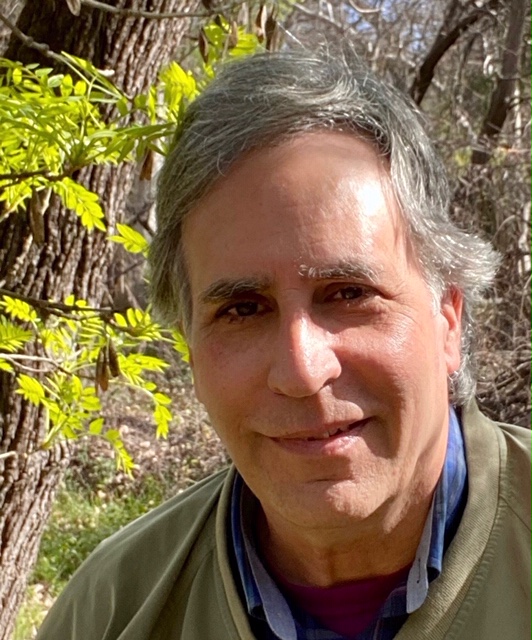Genesis Revisited: Darkness and Evil

Click to enlarge
When I first moved to this northern California town over a decade ago, there were still areas along the creek just outside of town that were quite wild. I would sometimes cross paths with coyotes, long-eared rabbits, and rattlesnakes. An encounter with the latter redefined Genesis for me.
At that time the paved bike path ended a quarter mile beyond the elementary school. A half-mile further on, the dirt path ended. Whenever I could, I’d walk to the end, go down to the creek, and take a sitting.
Shortly after settling in and attuning to my environment one day, I heard a rustle in the grass nearby. Not thinking too much of it, I remained seated. The rustling grew louder; whatever it was, it was coming directly towards me.
A few seconds later I saw a large rattler, whereupon the brain instantaneously bypassed the decision-making ‘me’ and made springs of my arms and legs. You wouldn’t think it possible to jump off the ground from a cross-legged seated position, but I did so.
The rattlesnake, which was a fat-bodied specimen over a meter long, stopped moving. A growing fascination overtook the primal fear, and I did a strange thing. I sat back down. As soon as I did, the snake began moving toward me again, albeit at an angle this time.
Recalling that rattlesnakes generally aren’t aggressive, and cannot strike more than a third of their length, I figured that as long as it was an arm’s length away, I was OK. It stopped about that far away, and stretched out beside me.
For 45 minutes I took a meditation next to a motionless, outstretched rattlesnake. Needless to say, it was one of the most intense sittings of my life.
Walking back past the kids playing in the schoolyard, I felt like I’d been alone in a wilderness for a few nights. The juxtaposition of being so close to such a wild creature, against the pavement and manicured lawns of town, felt surreal. Some lines from Genesis came to mind.
“And the serpent said unto the woman, “Ye shall not surely die: For God doth know that in the day ye eat of the tree which is in the midst of the garden, then your eyes shall be opened, and ye shall be as gods, knowing good and evil.”
Was the writer of Genesis, which contains passages of great spiritual power and poetry, telling a children’s story? Or was his meaning subtler, “more subtle than any beast of the field that the Lord God had made?”
“The day thou eatest of the knowledge of good and evil thou shalt surely die,” God said. Something died all right that allegorical day in Eden, but it was the bliss of ignorance in the animal state.
Disregarding the claptrap about the Bible being the literal “word of God,” what was the author of this narrative, entitled “Punishment for Disobedience” in the King James Version, attempting to convey to people?
Clearly, humans did not become human until we ate “of the tree of knowledge of good and evil.” Therefore, prohibition and punishment make no sense.
Nor does it make sense that humans became human by disobeying God’s command that they not eat from that metaphorical tree. Why does the writer of Genesis have a serpent tempting humans to become human, thereby beginning the journey to “be as gods?”
God’s alleged injunction was clearly meant as a warning: ‘Begin down this path and you cannot turn back.’
Darkness has two aspects; but evil has only one. There is both an individual and collective content to darkness. The individual content is all the negative things we’ve inherited through our families, lineages, and cultures.
This is the accumulation of fear, hate, envy, violence, and prejudice that we’ve absorbed, both as ‘original sin’ from childhood conditioning, and from our own unaddressed negligence and wrongdoing.
Collective darkness, on the other hand, is the sum total of the harmful content within a people, and human consciousness. Evil is the intentional component of collective darkness.
Strictly speaking, no individual, however monstrous, is evil. A person can only make or allow themselves to become a conduit for the collective darkness in consciousness, and an instrument of its direction.
Responsibility for the totality of the content of darkness within oneself is therefore the prerequisite of autonomy.
Parents, if you care to protect your children against darkness and evil, own your own darkness completely, including the unseen 90% below the surface, and be aware of collective darkness.
Just as an individual can cross a line beyond which it’s very difficult to return, so too can a people. I don’t know about other peoples, but Americans crossed that line even before Clinton came into office. Bush was just the icing on the bloody cake. The question is: What is Obama?
- Martin LeFevre is a contemplative, and non-academic religious and political philosopher. He has been publishing in North America, Latin America, Africa, and Europe (and now New Zealand) for 20 years. Email: martinlefevre@sbcglobal.net. The author welcomes comments.



 Peter Dunne: Dunne's Weekly - While We're Breaking Up Monoliths, What About MBIE?
Peter Dunne: Dunne's Weekly - While We're Breaking Up Monoliths, What About MBIE? Adrian Maidment: Supermarket Signs
Adrian Maidment: Supermarket Signs Ian Powell: Revisiting Universalism
Ian Powell: Revisiting Universalism Martin LeFevre - Meditations: In A Global Society, There Is No Such Thing As “National Security”
Martin LeFevre - Meditations: In A Global Society, There Is No Such Thing As “National Security” Binoy Kampmark: Secrecy And Virtue Signalling - Another View Of Signalgate
Binoy Kampmark: Secrecy And Virtue Signalling - Another View Of Signalgate Gordon Campbell: On The Americanising Of NZ’s Public Health System
Gordon Campbell: On The Americanising Of NZ’s Public Health System